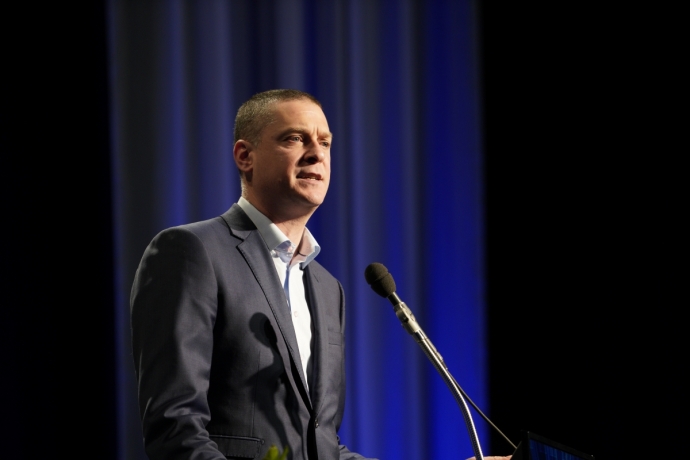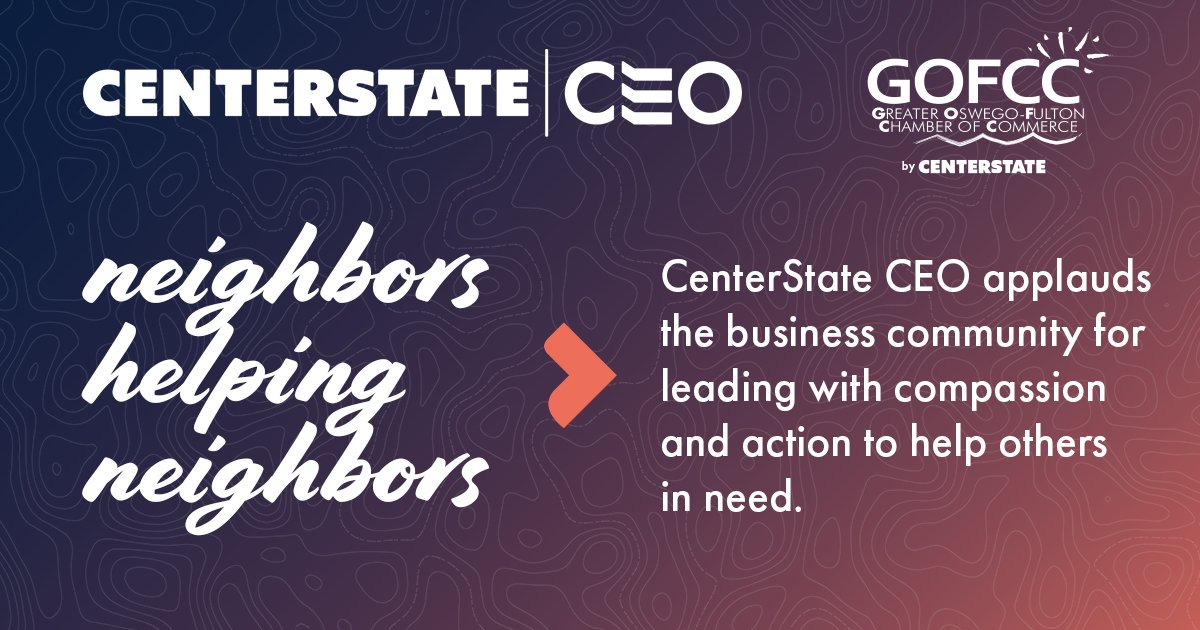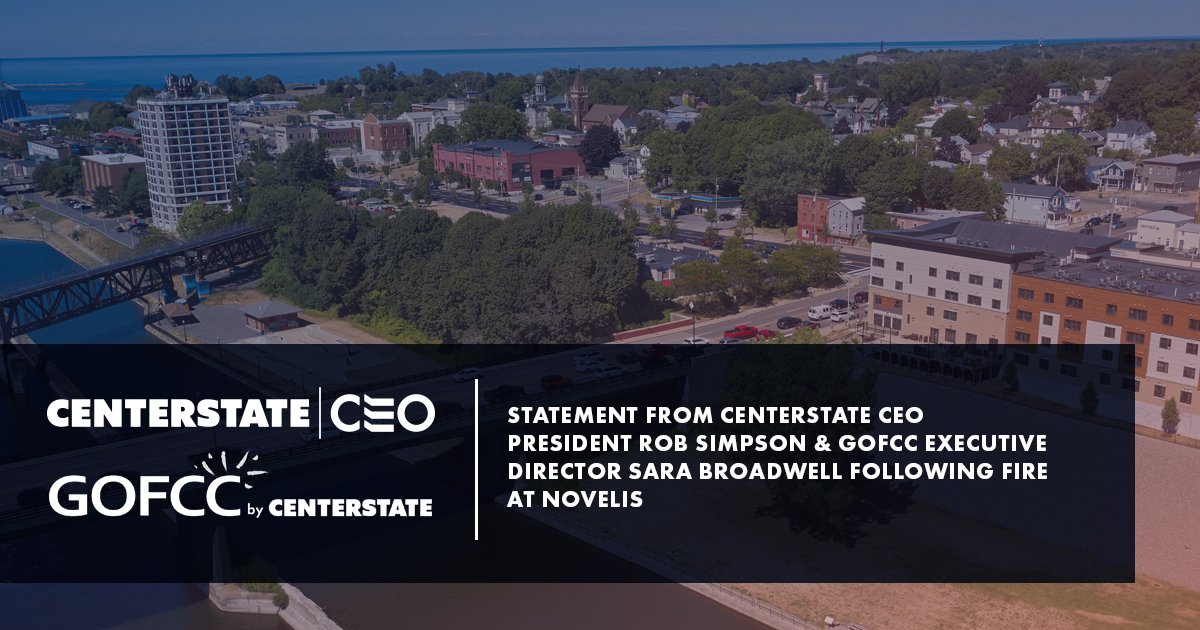Remarks by Robert M. Simpson CenterState CEO Economic Forecast Breakfast
Posted On |
Image

|
Good morning.
Let me begin by saying thank you to St. Joseph’s Health, and M&T Bank. We are deeply appreciative of your support of this event and of our agenda for economic growth and shared prosperity in Central New York.
To all of our members and partners who have joined us today, thank you also.
And to the staff at CenterState CEO, thank you for your commitment to our organization and to our work.
As we begin this New Year, and new decade, we do so with a new confidence that our regional economy is headed in the right direction. And it’s refreshing to hear what I think might be Gary’s most upbeat outlook in years, which gives us a great reason to look at our region’s economic position with optimism.
Gary forecasts that the strength of the overall national economy will continue through 2020. Likewise, the region’s growth of the past three years is anticipated to continue, with Real GDP growth strong at about 1%. Job growth has also accelerated over the past year, closing the gap as compared to the national average, which supports a near-record low unemployment rate.
These statistics and other indicators, underscored by our own research, tell a new story of economic advancement for the region.
Taking a closer look at job growth, we are seeing some of the best statistics in decades, highlighting the private sector’s role in driving the region’s economic resurgence.
According to the NYS Department of Labor, in every month of 2019 the Syracuse MSA grew jobs over the previous year at a rate of more than 2%. That is a higher rate than NYS as a whole, and nearly 3.5 times the rate of job growth in the combined regions of Albany, Buffalo and Rochester.
Wages were also up 4% in Syracuse from November 2018 to November 2019.
This progress is also driving another metric of success, population growth. While Gary pointed out that over a 13 year period, the larger region lost population, in Syracuse we are seeing a different trend. In fact, the Syracuse Metro area is an outlier as over a five year period it saw a 5.1% jump in its population of 25-34 year olds according to Census estimates. And according to American Community Survey data, from 2010 to 2018, there was 12.8% growth in millennials in Onondaga County with the largest actual gain in the City of Syracuse with an increase of 9.3%. In fact, Syracuse’s gain in millennials accounted for 28% of the gain in millennials in Onondaga County.
For the past decade or more, we have heard over and over about “brain drain.” How our young people were not staying. How we failed to hold on to our student population. Yet today’s reality is starkly different. We are seeing an increase in the number of young people staying in Syracuse following college and more folks choose to come to here to live and work in this vibrant urban center. This growth in Syracuse serves as an important reminder that a vibrant city is critical to our region’s strength.
And we know that a vibrant City requires opportunity for all – not just for a few. Which is why, as we examine our community’s unacceptable rates of poverty and economic segregation, there is reason to be hopeful that this critical problem is, at a minimum, no longer getting worse and may in fact be improving, though at a rate that demands continued if not increased vigilance.
Since 2012, Black and African American poverty has gone down more than 3%. That is on par with Buffalo, and an improvement over cities like Rochester which saw an increase in its poverty rate, and Detroit, which was unchanged.
And for Hispanics and Latinos poverty went down more than 11% outpacing Rochester, Buffalo and even Detroit.
Furthermore, the Brookings Metro Monitor also reported major improvements in measurements of inclusion, employment rates and median earnings increased for people of color, while median earnings gaps and poverty rates decreased.
While the overall rate of poverty remains far too high, we are beginning to see the numbers move in the right direction. And while we must not make the mistake of masking the true human toll of racial and socio-economic equality in marginal statistical improvement, we must also not fail to acknowledge even slight progress so as to reinforce the collaborations and partnerships that have rightly formed to focus our community’s attention and resources on this pressing need.
All of these statistics – of GDP and job growth, low unemployment, population growth and more -- create the foundation of a new and emerging narrative for our community. A more positive outlook than in years past, and one that is further reflected in the Economic Forecast report you have in front of you.
In that report you’ll note that seventy-four percent of our forecasters say the past year was either strong or very strong. This year, that optimism increases with seventy-six percent who anticipate a very strong to strong year ahead.
Forty-nine percent expect to make capital investments.
Seventy percent expect sales and revenue to expand in 2020.
Sixty-five percent of you say you’ll be hiring in 2020.
But beyond the statistical evaluation of our regional economy is a feeling that something is truly different now. That the trajectory we are on is the right one. That our community is on a path to realizing its full economic potential.
For too many years our forecasters used words slow, cautious, uncertain, challenging, and stagnant to describe our economy. So it was notable that this year the forecasters from our business community instead used words like vibrant, evolving, growing, progress, strong, robust and diverse to describe the economy and their outlook for the year. Those are your words.
It’s a sentiment echoed time and again in meetings with our members and partners. It’s optimism born from seeing transformative projects take shape in our community, and our elected leaders aligned in their objectives. It is a direct reflection of your work and our collective efforts to focus and execute on economic strategies rooted in data and best practices.
Take for example our innovation ecosystem. Fifteen years ago The Tech Garden first opened. At the time the region ranked dead last by most measures for supporting entrepreneurs. But the business community and local leaders saw beyond that challenge at the opportunity to align the resources and investments to create what’s now a robust ecosystem able to support companies at all stages of the growth cycle. An ecosystem that has grown to the point where The Tech Garden is in need of a major expansion to meet the demand of entrepreneurs in the pipeline who are looking for acceleration space, resources and programming. This year we will see The Tech Garden grow upwards by two floors adding 46,000 square-feet of incubation and acceleration space.
And just yesterday, one of our most visible programs, GENIUS NY, welcomed its fourth round of participants. Those five companies, which come from all over the world, are now here, in Syracuse, ready to grow their businesses. These companies join the more than 15 GENIUS NY participants from the competition’s first three rounds that are still here, growing and scaling their businesses with continued support from our Tech Garden.
And it isn’t just our startup businesses succeeding. From our larger employers and anchor institutions investing in their growth, to our small businesses who are the backbone of our economy, including the 95 new businesses we celebrated last fall for opening their doors, to the ongoing surge in downtown redevelopment our business community is engaged in our strategic vision and directly contributing to our economic progress.
Part of our strategy has been to be thoughtful about how and where we target investments, particularly in our urban centers, to accelerate our impact. We all can see the incredible transformation that has happened across downtown. Now we are looking for new opportunities to target investments in areas of the city that have historically lagged in this area. In Syracuse’s Southeast Gateway, we can advance development that generates community wealth and prosperity, and supports the investments being made by JMA and Salina 1st, among others.
And by advancing strategies that align with targeted industries like unmanned systems we have seen the emergence of an entire new sector for our economy. It's been eight years since we helped form NUAIR, to advance the safe integration of drones in the national airspace system and unlock the economic potential of their commercial use. Eight years since we believed that it
was possible to build on our globally competitive electronic and digital sensor technology industry base, led by businesses like Saab, SRC, and Lockheed Martin to create an environment not only for those companies to be successful but to attract new opportunities for the region.
To date we have seen nearly $848 million in private investment in the UAS industry here, more than 2,000 jobs and nearly 30 companies growing in Central New York. Through the launch of the region’s first beyond visual line of sight test corridor and the recently proposed small UAS testing facility at Griffiss International Airport, we hold world-class capabilities that will only accelerate our leadership position in this important industry.
Aligning strategies and investments to key industries isn’t exclusive to the UAS sector. We are seeing similar opportunities when it comes to warehousing and logistics with sites in Clay and now DeWitt being developed. Just five years ago, we were one of the most vocal advocates for investments to support the growth of this sector because the data told us, unequivocally, of the opportunity for our region. And today we are proud to work alongside County Executive Ryan McMahon and others to bring these important projects online, bringing with them hundreds of good paying jobs with benefits and career ladders accessible to those in our community who need them most.
Underlining all of these efforts is one competitive advantage that we have above our upstate peers: business, civic and elected leaders who are collaborating and actively working towards a common vision.
These are the elements that have taken this region from strategy to reality. From slow and steady to vibrant and strong.
And while we are undeniably in the midst of a strong growth cycle, the work before us isn’t done. We must use this momentum to speed up our progress and the challenges we collectively face.
Because, yes, while the data points to some progress when it comes to poverty, specifically among minority populations, just a few blocks from here there are still far too many people worried about how they are going to pay their bills and put food on the table this week.
And even though our forecasters shared unparalleled positivity for the year ahead, they too are mindful of potential headwinds and pressure points.
Their biggest concern: talent. Ranked again as the most significant pressure employers face in the year ahead, more than double any other pressure they face.
Low unemployment rates coupled with the retirements of older employees – who often have significant experience and historical knowledge of a company or organization - mean opportunities for growth often aren’t realized. We know employers are struggling to find, attract and retain qualified employees. In fact, there are more than 3,100 jobs at nearly 230 companies available right now in Central New York.
And the shrinking labor pool that Gary Keith pointed out has the potential to stunt the growth potential of our economic resurgence.
Which is why we have already begun to work towards solutions to address our region’s significant talent need. In October, we launched the Good Life CNY in partnership with Advanced Media New York. Targeted marketing efforts to drive traffic to this new quality of life and job portal site for our region is already yielding results, with the highest number of visits coming from Washington DC, New York City, Philadelphia, Columbus and Canton OH, and Boston.
In fact, more than 6,000 users have visited goodlifecny.com and more than 1,600 have specifically clicked on the talent connect job board. There, visitors can review the 3,146 jobs available across key industries. Additionally, nearly 40 job seekers have joined the talent network with a variety of skill ranges from entry level to 15+ years of experience.
And as we continue to develop strategies to attract talent and address workforce needs, we celebrate the news that Gov. Cuomo will establish the state’s first regional science, technology, engineering, arts and mathematics, or STEAM, high school in Syracuse, as well as a worker training center that will offer high school equivalency degrees, advanced technical certification and college degrees. This $71.4 million investment to renovate Central Tech High School into a multipurpose complex builds on Mayor Walsh and County Executive Ryan McMahon’s vison to educate and train the children and workforce of today for the jobs of the future.
Borrowing from the Work Train model of workforce development, last week, Mayor Ben Walsh announced Syracuse Build, an important initiative designed to support Syracuse’s construction boom by connecting capable job seekers from Syracuse’s historically marginalized communities with career pathways.
The continued development in the urban core, the University Hill, the impending construction of a replacement to the existing 81, and implementation of Syracuse Surge and Blueprint 15 will result in numerous opportunities for diverse city residents in construction related fields. To capitalize on this opportunity the City of Syracuse convened anchor partners, including Onondaga County and Syracuse University. With the support of a National Fund for Workforce Solutions grant, funded by the Ballmer Group, CenterState CEO has been serving in an advisory role on the project, supporting the design and incubation of a new approach that breaks down silos and holistically addresses the needs of employers and job seekers.
The result of this work is a partnership that connects local government, anchor institutions and construction firms to a coordinated network of community, training and workforce partners, with a goal of filling 100 jobs by the end of 2020.
And so, as we embark on a new decade, this is the economic landscape in which we find ourselves. Let’s take a small moment to celebrate our collective progress. We have, in fact, come a long way.
And then, let us turn our focus to the position we want our region to be in when we begin 2030. Because today’s progress can continue. It can accelerate. And MY economic forecast is that we will look back on this moment as the beginning of our turning point.
As you leave here today, please take this message of success and help us amplify it. Tell your neighbors, your colleagues and your friends and family that the Syracuse and Central New York of today is strong, progressing and yes, vibrant. Because the lesson of the past decade is clear: there is no obstacle so difficult as to resist our collective efforts.
Thank you.
Other
CEO News







CEO News | 11/21/2025Request for Proposals: 1300 South Salina Street Site Master DeveloperCenterState CEO and ONRAMP (the Project Sponsors) are requesting proposals from experienced Master Developers who can prove through their submittal that they possess the necessary qualifications to implement a comprehensive redevelopment… |



